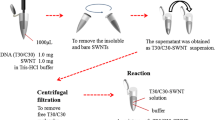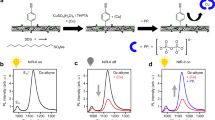Abstract
In this work, large-scale and single-crystalline ZnO nanotubes were fabricated by a simple technique from an aqueous solution at a low temperature of 65 °C. According to detailed morphology, structural and compositional analyses showed that the ZnO nanotubes [diameter ~200 nm (wall thickness ~50 nm); length ~1 µm] have single-crystallite with wurtzite structure. As-prepared ZnO nanotubes showed an effective fluorescence quenching for the detection of calf thymus DNA. In particular, increasing DNA concentrations (5–50 µM) into the fixed concentration of ZnO nanotubes (50 µM) progressively quenched the intrinsic fluorescence of nanotubes, which showed that the nanotubes fluorescence was efficiently quenched upon binding to DNA. At the highest ZnO-DNA molar ratios of 1:1.8, around 50.1 % of fluorescence quenching of DNA was observed. Significance of this study provides simple, cost-effective, and low temperature synthesis of ZnO nanotubes revealed better fluorescence property toward a platform of DNA sensor.
Graphical Abstract
ZnO nanotubes with diameter of ~200 nm (wall thickness ~50 nm) and length of about 1 µm prepared at low temperature (65 °C) showed fluorescence was efficiently quenched upon binding to DNA. In particular, around 50.1 % of DNA fluorescence quenching at the highest ZnO-DNA molar ratios of 1:1.8 was observed.








Similar content being viewed by others
References
You CC, Miranda OR, Gider B, Ghosh PS, Kim I, Erdogan B, Krovi SA, Bunz UHF, Rotello VM. Detection and identification of proteins using nanoparticle–fluorescent polymer ‘chemical nose’ sensors. Nat Nanotechnol. 2007;2:318.
Bunz UH, Rotello VM. Gold nanoparticle-fluorophore complexes: sensitive and discerning “noses” for biosystems sensing. Angew Chem Int Ed. 2010;49:3268.
Haab BB. Applications of antibody array platforms. Curr Opin Biotechnol. 2006;17:415.
Chen XQ, Zhou Y, Peng XJ, Yoon JY. Fluorescent and colorimetric probes for detection of thiols. Chem Soc Rev. 2010;39:2120.
Zhang K, Zhou HB, Mei QS, Wang SH, Guan GJ, Liu RY, Zhang J, Zhang ZP. Instant visual detection of trinitrotoluene particulates on various surfaces by ratiometric fluorescence of dual-emission quantum dots hybrid. J Am Chem Soc. 2011;133:8424.
Han MY, Gao XH, Su JZ, Nie S. Quantum-dot-tagged microbeads for multiplexed optical coding of biomolecules. Nat Biotechnol. 2001;19:631.
Wang ZL. Electron and ionic transport in high-radioactive silicate alkali-earth glasses. J Phys Conds Matter. 2004;16:829.
Huang MH, Mao S, Feick H, Yan H, Wu Y, Kind H, Weber E, Russo R, Yang P. ChemInform Abstract: room-temperature ultraviolet nanowire nanolasers. Science. 2001;292:1897.
Zhang Z, Sun YH, Zhao YG, Li GP, Wu T. Manganite thin film/ZnO nanowire (nanosheets) p-n junctions. Appl Phys Lett. 2008;92:103113.
Kind H, Yan HQ, Messer B, Law M, Yang PD. Nanowire ultraviolet photodetectors and optical switches. Adv Mater. 2002;14:158.
Li YD, Li X, He R, Zhu J, Zhao X. Artificial lamellar mesostructures to WS 2 nanotubes. J Am Chem Soc. 2002;124:1411.
Wang ZL, Kong XY, Ding Y, Gao PX, Hughes WL, Yang RS, Zhang Y. Semiconducting and piezoelectric oxide nanostructures induced by polar surfaces. Adv Funct Mater. 2004;14:943.
Li QH, Gao T, Wang YG, Wang TH. Adsorption and desorption of oxygen probed from ZnO nanowire films by photocurrent measurements. Appl Phys Lett. 2005;86:123117.
Wang ZL. Zinc oxide nanostructures: growth, properties and applications. J Phys Condens Matter. 2004;16:829.
Vayssieres L, Keis K, Hagfeldt A, Lindquist S. Three-dimensional array of highly oriented crystalline zno microtubes. Chem Mater. 2001;13:4395.
Baruah S, Dutta J. Hydrothermal growth of ZnO nanostructures. Sci Technol Adv Mater. 2009;10:013001.
Yang JH, Zheng JH, Zhai HJ, Yang LL, Liu L, Gao M. Solvothermal growth of highly oriented wurtzitestructured ZnO nanotube arrays on zinc foil. Cryst Res Technol. 2009;44:619.
Wang Z, Li L. Highly ordered zinc oxide nanotubules synthesized within the anodic aluminum oxide template. Appl Phys A. 2002;74:201.
Kong XH, Sun XM, Li XL, Li YD. Catalytic growth of ZnO nanotubes. Mater Chem Phys. 2003;82:997.
Liang HW, Lu YM, Shen DZ, Li BH, Zhang ZZ, Shan CX, Zhang JY, Fan XW, Du GT. Growth of vertically aligned single crystal ZnO nanotubes by plasma-molecular beam epitaxy. Solid State Commun. 2006;137:182.
Zhang BP, Binh NT, Wakatsuki K, Segawa Y, Yamada Y, Usami N, Kawasaki M, Koinuma H. Formation of highly aligned ZnO tubes on sapphire (0001) substrates. Appl Phys Lett. 2004;84:4098.
Feng XJ, Feng L, Jin MH, Zhai J, Jiang L, Zhu DB. Reversible super-hydrophobicity to super-hydrophilicity transition of aligned zno nanorod films. J Am Chem Soc. 2004;126:62–63. doi:10.1021/ja038636o.
Chae KW, Zhang Q, Kim JS, Jeong YH, Cao G. Low-temperature solution growth of ZnO nanotube arrays. Beilstein J Nanotechnol. 2010;1:128–34.
Vayssieres L, Keis K, Hagfeldt A, Lindquist SE. Three-dimensional array of highly oriented crystalline Zno microtubes. Chem Mater. 2001;13:4395–98.
Lakowicz JR. Principles of fluorescence spectroscopy. 3rd ed. New York: Springer; 2006, p. 278–82.
Bresloff JL, Crothers DM. Equilibrium studies of ethidium-polynucleotide interactions. Biochemistry. 1981;20:3547–53.
Yu QJ, Fu WY, Yu CL, Yang HB, Wei RH, Li MH, Liu SK, Sui YM, Liu ZL, Yuan MX, Zou GY. Fabrication and optical properties of large-scale zno nanotube bundles via a simple solution route. J Phys Chem C. 2007;111:17521.
Li Y, Meng GW, Zhang LD, Phillipp F. Ordered semiconductor ZnO nanowire arrays and their photoluminescence properties. Appl Phys Lett. 2000;76:2011.
Decremps F, Ellicer-Porres J, Saitta AM, Chervin JC, Polian A. High-pressure Raman spectroscopy study of wurtzite ZnO. Phys Rev B. 2002;65:092101.
Yu WD, Li XM, Gao XD, Qiu PS, Cheng WX, Ding AL. Effect of zinc sources on the morphology of ZnO nanostructures and their photoluminescence properties. Appl Phys A. 2004;79:453.
Wahab R, Ansari SG, Kim YS, Seo HK, Shin HS. Room temperature synthesis of needle-shaped ZnO nanorods via sonochemical method. Appl Surf Sci. 2007;253(18):7622.
Yang CL, Wang JN, Ge WK, Guo L, Yang SH, Shen DZ. Enhanced ultraviolet emission and optical properties in polyvinyl pyrrolidone surface modified ZnO quantum dots. J Appl Phys. 2001;90:4489.
Wong EM, Hoertz PG, Liang CJ, Shi BM, Meyer GJ, Searson PC. Influence of organic capping ligands on the growth kinetics of ZnO nanoparticles. Langmuir. 2001;17:8362.
Spanhel L, Andersen A. Semiconductor clusters in the sol-gel process: quantized aggregation, gelation, and crystal growth in concentrated zinc oxide colloids. J Am Chem Soc. 1991;113:2826.
Sun H, Zhang Q-F, Wu JL. Electroluminescence from ZnO nanorods with an n-ZnO/p-Si heterojunction structure. Nanotechnology. 2006;17:2271.
Huang MH, Mao S, Feick H, Yan H, Wu Y, Kind H, Weber E, Russo R, Yang P. Catalytic growth of zinc oxide nanowires by vapor transport. Science. 2001;292:1987.
Mulligan RF, Iliadis AA, Kofinas PJ. Synthesis and characterization of ZnO nanostructures templated using diblock copolymers. Appl Polym Sci. 2003;89:1058.
Satriano C, Fragala ME, Aleeva Y. Ultrathin and nanostructured ZnO-based films for fluorescence biosensing applications. Sens Actuators B. 2012;161:191.
Khun K, Ibupoto ZH, Chey CO, Lu Jun, Nur O, Willander M. Comparative study of ZnO nanorods and thin films for chemical and biosensing applications and the development of ZnO nanorods based potentiometric strontium ion sensor. Appl Surface Sci. 2013;268:37–43.
Zhao M, Huang J, Zhou Y, Chen Q, Pan X, He H, Ye Z. A single mesoporous ZnO/Chitosan hybrid nanostructure for a novel free nanoprobe type biosensor. Biosens Bioelectron. 2013;43:226–30.
Supriya S, Pranab S. Understanding the interaction of DNA–RNA nucleobases with different ZnO nanomaterials. Phys Chem Chem Phys. 2014;16:15355.
Acknowledgments
This work was supported by the Internal Research Grant, Alfaisal University (IRG 2014) project No. 4050101011410. The authors gratefully acknowledge the continued support from Alfaisal University and its office of Research.
Author information
Authors and Affiliations
Corresponding authors
Ethics declarations
Conflict of interest
The authors declare that they have no competing interests.
Electronic supplementary material
Rights and permissions
About this article
Cite this article
Ahmed, F., Arshi, N., Dwivedi, S. et al. Low temperature growth of ZnO nanotubes for fluorescence quenching detection of DNA. J Mater Sci: Mater Med 27, 189 (2016). https://doi.org/10.1007/s10856-016-5805-3
Received:
Accepted:
Published:
DOI: https://doi.org/10.1007/s10856-016-5805-3




